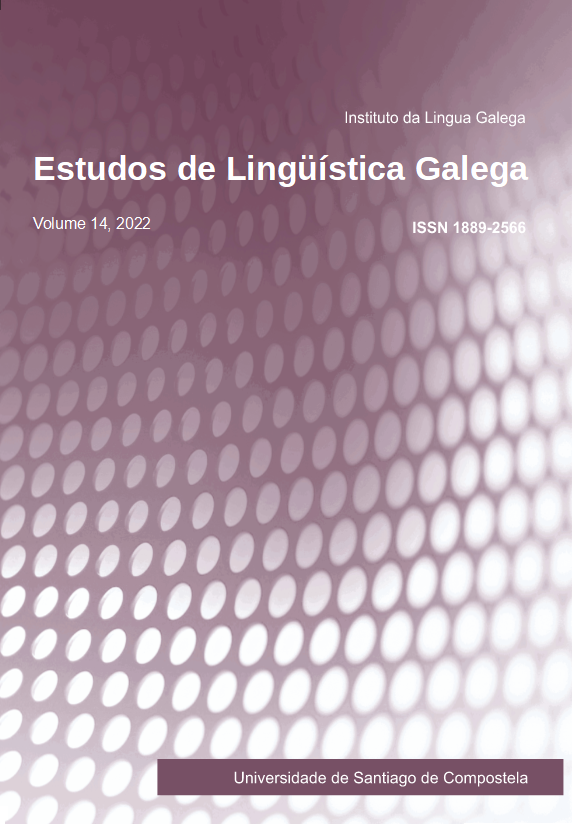Diachronic evidence for durative constructions in Portuguese and Galician
Main Article Content
Abstract
The main objective of the present study is to examine the syntactic and semantic functioning of periphrastic present durative tenses the syntax of which contains either a gerund or an infinitive. The coexistence of both with a similar semantic value raises the question why there are two constructions, which this paper attempts to use diachronic data to answer. Given the existence of two periphrases with the same meaning, namely the idea of action in progress, we will ask how this was expressed in Latin using a different periphrastic construction. The paper traces the process of replacement of the Latin construction by those found in Portuguese and Galician, identifying a series of changes which help to explain how the new construction emerged. Given that the constituents of these constructions are auxiliary verb, (link) and main verb, this approach leads to a comparison between the Latin auxiliary verb esse and the Portuguese/Galician auxiliary estar, and also between the forms taken by the main verb, namely the Latin present participle versus the gerund or gerundial infinitive in Portuguese and Galician; hence the need to analyse the Latin forms. Special emphasis will be laid upon the gerund, which has very different functions in Latin from those which it has acquired in modern Romance languages; the latter are reminiscent of the English gerund, with which the Romance gerund will be compared to achieve a better understanding of its earlier functions. The comparison will be broadened to include other Romance languages so as to examine the similarities and differences in the solutions found. Having compiled all the data, an explanation will then be sought for the coexistence of two synonymous constructions which takes into account the chronology of changes on the basis of written records extending from the thirteenth century to the present day, in order to establish which construction is the older of the two and their frequency in European Portuguese (PE), Brazilian Portuguese (PB) and Galician. The theoretical framework of this study draws on principles defended by Mattos and Silva (1989, 2008, vols I and II); existing corpora are used as sources of data.
Keywords:
Article Details
References
Álvarez, Rosario / Xosé Xove (2002): Gramática da lingua galega. Vigo: Galaxia.
Bartoli, Matteo (1928): Breviario di neolinguistica. Modena: Mucchi Editore (em colaboração com Giulio Bertoni).
Bassols, Mariano (1956/2015): Sintaxis latina. CSIC: Madrid, 1956; Barcelona: Universitat de Barcelona, 2015.
Bertinetto, Marco Pier et al. (2000): “The progressive in Europe”, em Östem Dahl (ed.), Tense and Aspect in the languages of Europe. Berlín / New York: Mouton de Gruyten, 559-664.
Brea, Mercedes (1985): “Las preposiciones, del latín a las lenguas románicas”, Verba. Anuario Galego de Filoloxía 12, 147-182.
Brocardo, Maria Teresa (2008): “Ainda a analogia (notas em torno da adequação descritiva e valor explicativo do conceito de analogia em linguística histórica)”, em Maria Luísa Soares et al. (eds.), Expressões da analogia. Lisboa: Colibri, 185-192.
[CdP] Davies, Mark / Michael Ferreira (2006-): Corpus do Português. National Endowment for the Humanities http://www.corpusdoportugues.org/
[CIPM] Corpus Informatizado do Português Medieval. Faculdade de Ciências Sociais e Humanas da Universidade Nova de Lisboa. http://cipm.fcsh.unl.pt/.
[CORGA] Centro Ramón Piñeiro para a investigación en humanidades: Corpus de Referencia do Galego Actual (CORGA) [3.0] http://corpus.cirp.gal/corga/
Diez, Friedrich (1836-1844): Grammatik der romanischen Sprachen [versão francesa: Grammaire des langues romaines, 1874-76, Paris].
Fernández Rei, Francisco (1991): Dialectoloxía da lingua galega. Vigo: Xerais.
Fiéis, Alexandra / Maria Lobo (2010): “Aspectos da sintaxe das orações gerundivas no português medieval e no português europeu contemporâneo”, em Ana Maria Brito et al. (eds.), Textos selecionados. XXV encontro nacional da Associação Portuguesa de Linguística. Porto: APL, 419-434.
Harto Trujillo, Mª Luisa (1994): “Notas sobre el gerundio y gerundivo”, Fortunatae: Revista canaria de filología, cultura y humanidades clásicas 6, 273-292.
Lausberg, Heinrich (19812 [19741]): Linguística Românica. Lisboa: Fundação Calouste Gulbenkian. (Ed. alemã 1963).
Lobo, Maria (2001): “On gerund clauses of Portuguese dialects”, em Alexandre Veiga et al. (eds.), El verbo. Entre el léxico y la gramática. Lugo: Ed. Tris Tram, 107-118.
Lobo, Maria (2008): “Variação morfo-sintáctica em dialectos do português europeu: o gerúndio flexionado”, Diacrítica 22/1, 25-55.
Maler, Bertil (1973): “L’infinitif gerondival portugais: quelques notes sur la propagation”, Stockholm Studies in Modern Philology 4, 250-268.
Mattos e Silva, Rosa Virgínia (1989): Estruturas trecentistas. Elementos para uma gramática do português arcaico. Lisboa: Imprensa Nacional Casa da Moeda.
Mattos e Silva, Rosa Virgínia (2008): O português arcaico. Uma aproximação, vols. I e II. Lisboa: Imprensa Nacional Casa da Moeda.
Meyer-Lübke, Wilhelm (1926): Introducción a la lingüística románica. Madrid: Gredos.
Mortimer, Liesbeth (2005): “Les périphrases aspectuelles progressives en français et en néerlandais. Présentation et voies de grammaticalisation”, em Hava Bat-Zeev Shyld-krot / Nicole Le Querler (eds.), Les périphrases verbales. Amsterdam / Philadelphia: John Benjamins, 83-102.
Mothé, Núbia (2007): Variação e mudança aquém e além mar: gerúndio versus infinitivo gerundivo no Português dos séculos XIX e XX. Universidade Federal do Rio de Janeiro. Dissertação de Mestrado.
Mothé, Núbia (2014): Notícias de Além-mar: Variação e Mudança no uso de infinitivo gerundivo no Português Europeu ao longo do século XX. Universidade Federal do Rio de Janeiro. Tese de Doutoramento.
Muñío Valverde, José Luis (1995): “Pervivencia del participio de presente activo”, Romanistisches Jahrbuch 46, 231-250.
[TILG] Santamarina, Antón (coord.): Tesouro Informatizado da lingua galega. Santiago de Composte- la: Instituto da Lingua Galega. http://www.ti.usc.es/tilg/.
[TMILG] Varela Barreiro, Xavier (dir.) (2004-): Tesouro Medieval Informatizado da Lingua Galega. Santiago de Compostela: Instituto da Lingua Galega. http://ilg.usc.es/tmilg/.
Väänänen, Veikko (2003 [1971]): Introducción al latín vulgar. Madrid: Gredos.
Webster’s New World Dictionary & Thesaurus (1998). New York: Macmillan Publishers.
Most read articles by the same author(s)
- Paulo Osório, Ramón Mariño Paz. Fonética e fonoloxía históricas da lingua galega. Vigo: Edicións Xerais de Galicia. 2017. 699 pp. , Estudos de Lingüística Galega: Vol 11 (2019)






